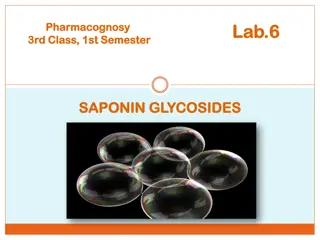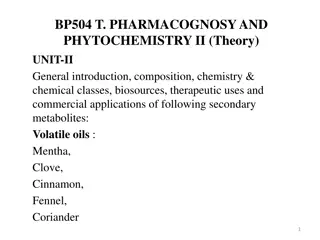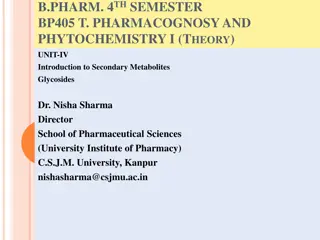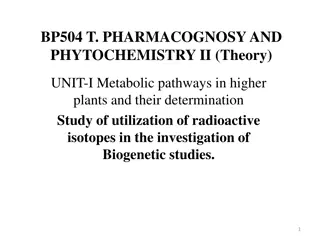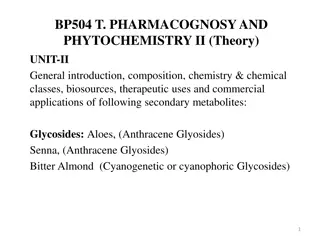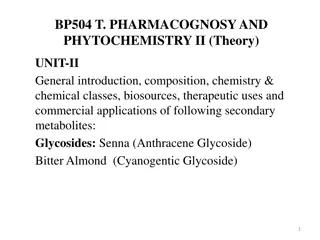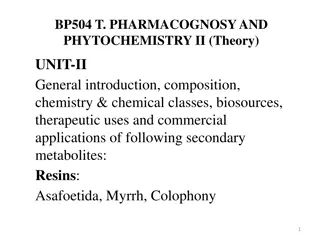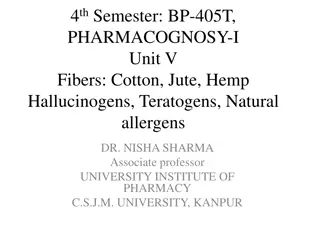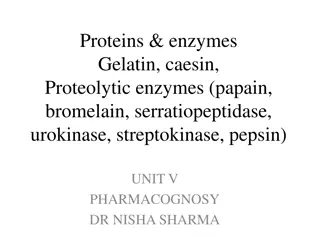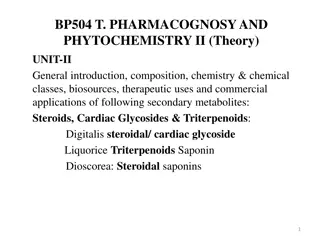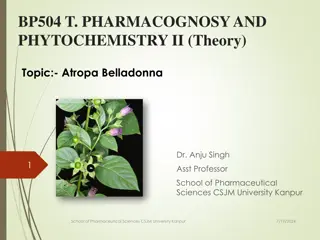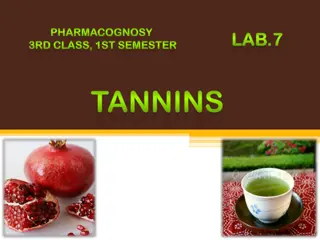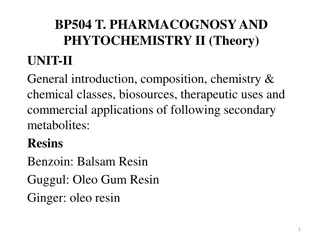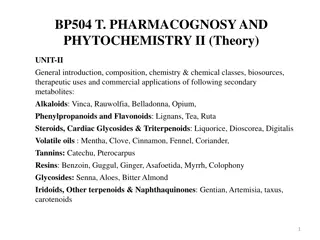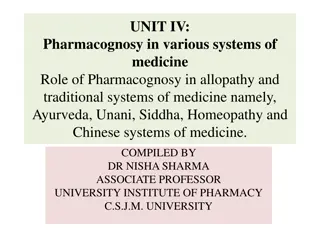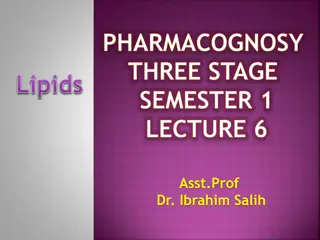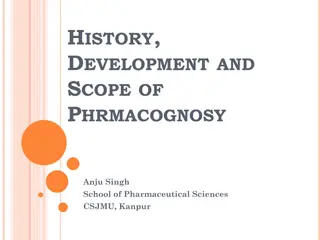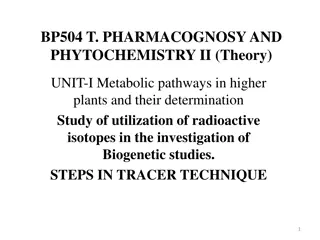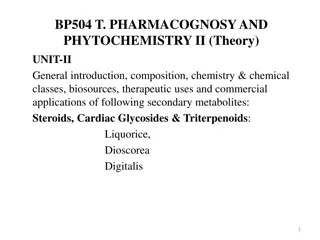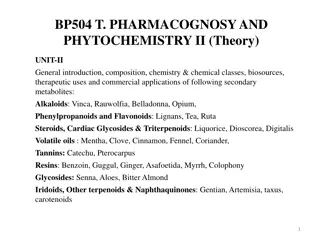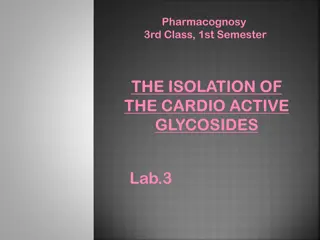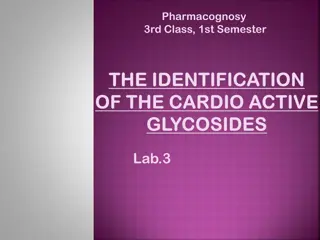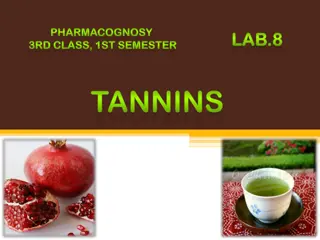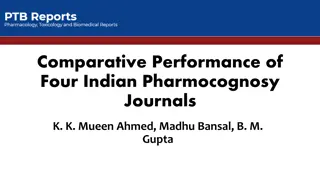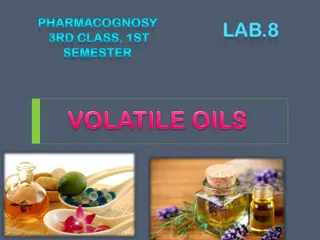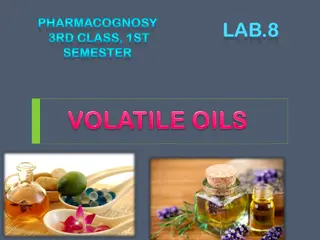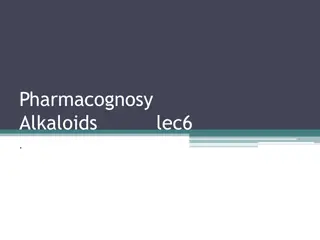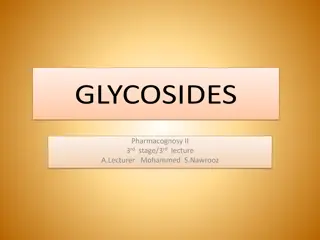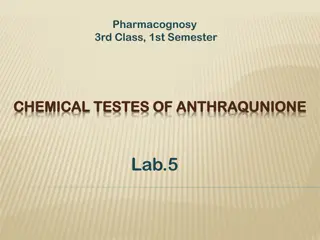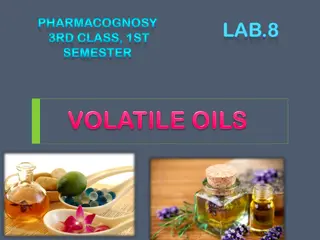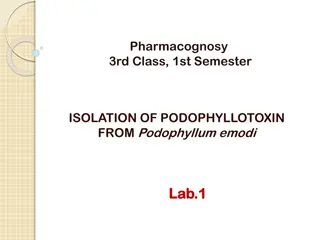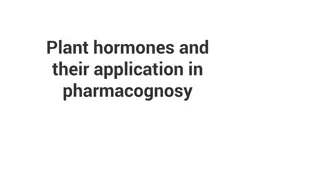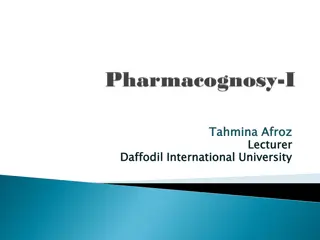Identification of Cardioactive Glycosides in Pharmacognosy Lab Experiments
In this Pharmacognosy lab session, students learn about the identification of cardioactive glycosides through chemical tests like Baljets Test and Keller-Killians Test. These tests involve specific procedures using reagents like picric acid, sodium hydroxide, glacial acetic acid, ferric chloride, an
0 views • 11 slides
Understanding Saponin Glycosides in Pharmacognosy: Properties and Applications
Saponin glycosides, found in various plants, are compounds with diverse benefits ranging from cholesterol regulation to potential anticancer properties. They form colloidal solutions in water and are used in soap manufacturing due to their unique properties. Additionally, saponins have bitter taste,
7 views • 18 slides
Understanding Anthraquinone Glycosides: Pharmacognosy Insights
Anthraquinone glycosides are compounds found in medicinal plants like Senna, Cascara, and Aloe, known for their therapeutic actions. These glycosides are hydrolyzed to yield active aglycones, which act as stimulant cathartics by increasing smooth muscle tone in the colon. Market formulations and ext
1 views • 11 slides
Volatile Oils in Pharmacognosy and Phytochemistry: Composition, Chemistry, Uses
Volatile oils, also known as essential oils, are derived from terpenes and their oxygenated compounds. These oils possess characteristic odors and are extracted from plants through various methods like hydro-distillation and steam distillation. They are commonly used as flavoring agents, perfumes, a
0 views • 29 slides
Sources of Crude Drugs: Plant, Animal, Marine, and Tissue Culture in Pharmacognosy
Crude drugs are natural substances obtained from plants, animals, and minerals. They are used without much processing and have therapeutic properties. Different plant parts like leaves, flowers, fruits, seeds, roots, bark, and stems yield various important drugs. Animals and minerals also serve as s
1 views • 19 slides
Understanding Glycosides: Secondary Metabolites in Pharmacognosy
Glycosides are naturally occurring compounds with sugar and non-sugar components. They are characterized by glycosidic bonds and can be chemically separated. These compounds exhibit various physical and chemical properties, including solubility, taste, and optical activity. Classification based on g
1 views • 11 slides
Techniques for Investigating Plant Metabolic Pathways and Biogenetic Studies
This content explores various techniques used in pharmacognosy and phytochemistry to investigate the metabolic pathways in plants and study the formation of primary and secondary metabolites. Methods such as utilizing radioactive isotopes, tracer techniques, isolated organs/tissues, grafting, and mu
4 views • 12 slides
Understanding Anthracene Glycosides in Pharmacognosy and Phytochemistry
Anthracene glycosides are secondary metabolites found in various plant families, offering therapeutic benefits. This comprehensive study explores their composition, chemistry, biosources, and applications, detailing the structural variations of aglycones and sugars present in these compounds. Method
0 views • 30 slides
Comparison of Alexandrian Senna and Indian Senna: Pharmacognosy and Phytochemistry Insights
Explore the pharmacognosy and phytochemistry of Alexandrian Senna and Indian Senna, detailing their collection, preparation, macroscopic and microscopic characteristics, chemical constituents, and potential adulterants. Learn about the therapeutic applications and commercial significance of these gl
0 views • 30 slides
Asafoetida: Composition, Collection, and Uses in Pharmacognosy
Asafoetida, also known as Gum Asafoetida or Devil's dung, is an oleo-gum resin obtained from Ferula species. It contains trans-ferulic acids and is harvested by incising the roots. The resin is collected, dried, and prepared for commercial use. Asafoetida has a distinct color, odor, and taste, and i
0 views • 24 slides
Exploring Fibers: Cotton, Jute, and Hemp - Pharmacognosy Insights
Discover the world of natural fibers such as cotton, jute, and hemp in pharmacognosy. Learn about their biological sources, chemical constituents, uses, and classification based on origin. Delve into the properties and applications of these fibers, alongside insights on hallucinogens and their effec
0 views • 16 slides
Understanding Proteins and Enzymes: Classification, Sources, and Applications
Proteins and enzymes play crucial roles in various biological processes. Enzymes act as catalysts, with different types classified based on their functions. Papain enzyme, derived from Carica papaya, exemplifies proteolytic enzymes used in the food and beverage industry as a meat tenderizer and in c
2 views • 15 slides
Pharmacognosy and Phytochemistry II: Secondary Metabolites and Their Therapeutic Applications
This unit delves into the composition, chemistry, therapeutic uses, and commercial applications of secondary metabolites such as steroids, cardiac glycosides, and triterpenoids. It explores the properties of saponin glycosides, their classification based on aglycone nature, and the significance of s
0 views • 23 slides
Isolation and Analysis of Podophyllotoxins from Resins in Pharmacognosy
Pharmaceutical resins like podophyllotoxins are obtained from plants using various extraction methods. Podophyllotoxin, a key compound, is isolated from Podophyllum roots using solvents and precipitation techniques. The properties and analysis of podophyllotoxin are also discussed, including identif
0 views • 16 slides
Pharmacognosy and Phytochemistry II: Atropa Belladonna Overview
Atropa belladonna, commonly known as belladonna, is a plant rich in tropane alkaloids like atropine and scopolamine. This plant, belonging to the Solanaceae family, has various medicinal uses. Its distinct morphology and geographical sources make it a significant botanical specimen in pharmacognosy
0 views • 13 slides
Understanding Tannins: Properties, Uses, and Structures in Pharmacognosy
Tannins, complex phenolic glycosides found in plants, have various properties such as water solubility and ability to precipitate proteins. They are important for their astringency and therapeutic uses in tanning, treating burns, and as antioxidants. The interaction of tannins with macromolecules is
3 views • 18 slides
Understanding Resins: Composition, Occurrence, and Classification
Resins are solid/semisolid amorphous products with complex chemical composition and are found in plants, animals, and fossils. They contain essential oils, terpene products, and carboxylic acids. Resins occur as a result of normal metabolism or in response to injury, forming physiological or patholo
1 views • 37 slides
Understanding Saponin Glycosides in Pharmacognosy: Properties and Applications
Saponin glycosides are plant compounds with diverse applications, from forming colloidal solutions to binding with cholesterol in the body. They possess bitter taste and detergent-like properties, offering benefits in health and industry. Learn about their structures, sources like Quillaia saponaria
3 views • 18 slides
Overview of Rauwolfia Alkaloids and Therapeutic Uses
Rauwolfia is a plant known for its alkaloids like Reserpine, Deserpine, and Ajmaline, with therapeutic applications in treating insanity and snake bites. These alkaloids are indole-based and occur in the roots of Rauwolfia plants. Reserpine, one of the major alkaloids, is a pale crystalline substanc
1 views • 13 slides
Role of Pharmacognosy in Various Systems of Medicine
Pharmacognosy plays a crucial role in modern medicine like allopathy and traditional systems such as Ayurveda, Unani, Siddha, Homeopathy, and Chinese medicine. It involves the study of natural products obtained from plants, animals, minerals, etc., and their use in treating various health conditions
0 views • 11 slides
Introduction to Lipid Biosynthesis and Fixed Oils in Pharmacognosy Lecture
In this lecture by Asst. Prof. Dr. Ibrahim Salih, the focus is on lipid biosynthesis, specifically the three phases involved: glycerol formation, fatty acid biosynthesis, and triglyceride production. The classification of fixed oils into drying, semi-drying, and non-drying categories based on their
0 views • 13 slides
History, Development, and Scope of Pharmacognosy
Pharmacognosy is the study of medicinal uses of crude drugs obtained from plants and natural resources. It involves researching physical, chemical, and biological properties of drugs from natural sources. The history of pharmacognosy dates back to prehistoric times, where the use of medicinal plants
0 views • 17 slides
Exploring Radio Tracer Techniques in Pharmacognosy and Phytochemistry II
In this unit, the focus is on metabolic pathways in higher plants and leveraging radioactive isotopes for biogenetic studies. Topics covered include steps in tracer techniques, selection of radioisotopes, preparation of labeled compounds, and insertion of radio-labeled metabolites in plant parts usi
0 views • 9 slides
Understanding Cardiac Glycosides in Pharmacognosy and Phytochemistry
Explore the role of Steroids, Cardiac Glycosides, and Triterpenoids in pharmacognosy and phytochemistry, focusing on their general introduction, composition, chemistry, biosources, therapeutic uses, and commercial applications. Learn about the structure and attachment of sugar parts in Cardiac Glyco
9 views • 9 slides
Overview of Indole Alkaloids in Pharmacognosy and Phytochemistry II
Indole alkaloids are a significant group of naturally occurring compounds with diverse chemical structures and physiological actions. This unit delves into the general introduction, composition, chemistry, biosources, therapeutic uses, and commercial applications of various secondary metabolites, in
0 views • 17 slides
Isolation of Cardioactive Glycosides in Pharmacognosy Lab: Procedure and Results
In this pharmacognosy lab experiment, the aim is to isolate cardioactive glycosides from plant material using various equipment and reagents. The procedure involves maceration, extraction, and separation steps to isolate Fraction A containing the whole glycoside. The results indicate successful isol
0 views • 8 slides
Identification of Cardioactive Glycosides in Pharmacognosy Lab Experiments
The lab experiments focus on identifying cardioactive glycosides using chemical tests like Baljets Test and Keller-Killians Test, along with the identification of sterol glycosides through Raymmonds and Kedds reactions. These tests involve specific procedures with different reagents to observe color
0 views • 11 slides
Essential Insights on Volatile Oils and Their Properties in Pharmacognosy
Explore the fascinating world of volatile oils in pharmacognosy with Dr. Nisha Sharma, an Associate Professor at C.S.J.M. University. Learn about the physical and chemical properties of volatile oils, their classification based on functional groups, and examples of different types of volatile oils u
0 views • 12 slides
Introduction to Practical Pharmacognosy: Study of Medicines from Natural Sources
Pharmacognosy is the study of medicines derived from natural sources, exploring drugs from plants through the lenses of botany, chemistry, and pharmacology. This includes the classification of vegetable drugs based on taxonomic, chemical, and morphological characteristics. Understanding key points f
0 views • 19 slides
Understanding Tannins in Pharmacognosy: Properties, Structure, and Uses
Tannins are phenolic compounds found in plants, known for their complex nature and diverse properties. They are soluble in various solvents, play a role in tanning leather, and have medicinal uses such as treating burns and acting as antioxidants. The interaction between tannins and macromolecules i
0 views • 18 slides
Comparative Performance of Indian Pharmacognosy Journals
Analysis of articles from four Indian pharmacognosy journals during 2010-2013 and their citations until 2015 revealed that Pharmacognosy Reviews outperformed others in terms of impact. Suggestions were made for journals to enhance quality through improved peer review standards and attracting eminent
0 views • 8 slides
Understanding Volatile Oils in Pharmacognosy: Properties, Composition, and Uses
Volatile oils, also known as essential oils, are complex plant products containing volatile principles. They are colorless but may darken over time. Immiscible with water, they have distinct odors and tastes, and are soluble in organic solvents. Officially sourced from plants, volatile oils have the
0 views • 13 slides
Understanding Volatile Oils in Pharmacognosy: Properties, Uses, and Applications
Volatile oils, also known as essential oils, are hydrophobic liquids extracted from plants containing volatile chemical compounds. These oils have diverse physical and chemical properties, making them valuable in various fields like aromatherapy, perfumery, and therapeutics. Learn about the differen
0 views • 12 slides
Overview of Alkaloids in Pharmacognosy
Alkaloids are a diverse group of compounds containing nitrogen that are derived from amino acids like phenylalanine or tyrosine. Protoalkaloids, such as ephedrine, are derived from common amino acids and do not contain a heterocyclic ring. Ephedrine, obtained from Ephedra sinica, has CNS stimulatory
0 views • 11 slides
Understanding Glycosides in Pharmacognosy: A Comprehensive Overview
Organic natural compounds known as glycosides are prevalent in plants and organisms, offering diverse therapeutic benefits. This article delves into the definition of glycosides, glycosidic linkages, and different types like O-, S-, N-, and C-glycosides, with examples from nature. The distinction be
0 views • 25 slides
Chemical Tests for Anthraquinone in Aloe Vera Extract
This pharmacognosy lab experiment focuses on identifying anthraquinone glycosides in aloe vera extract through chemical tests like Schonteten's reaction with borax and the bromine test for aloin. Special reagents like nitric acid and nitrous acid are also used for specific identification. The proced
0 views • 12 slides
Understanding Volatile Oils in Pharmacognosy: Properties and Applications
Volatile oils, also known as essential oils, play a crucial role in pharmacognosy due to their complex composition and therapeutic benefits. These oils are immiscible with water but soluble in organic solvents, and their chemical composition includes terpene derivatives and aromatic compounds. They
0 views • 11 slides
Understanding Podophyllotoxin: Isolation, Mechanism of Action, and Medicinal Uses
Learn about the isolation process of podophyllotoxin from Podophyllum emodi, a lignan with potential medicinal applications. Explore its mechanism of action as a tubulin polymerase inhibitor and its uses in treating genital warts and various cancers. The structure of podophyllotoxin and its signific
0 views • 14 slides
Understanding Plant Hormones and Their Role in Pharmacognosy
Plant hormones, also known as phytohormones, are essential chemical compounds in plants that regulate various developmental processes. They include auxins, gibberellins, cytokinins, ethylene, and abscisic acid, each with specific functions in growth, reproduction, and response to environmental stimu
0 views • 21 slides
Overview of Pharmacognosy and Natural Products
Pharmacognosy is the study of medicinal drugs derived from natural sources, focusing on the properties and origins of crude drugs like plants and animals. The term was coined in 1815, emphasizing knowledge of drugs' physical, chemical, and biological properties. It is associated with various branche
0 views • 18 slides

